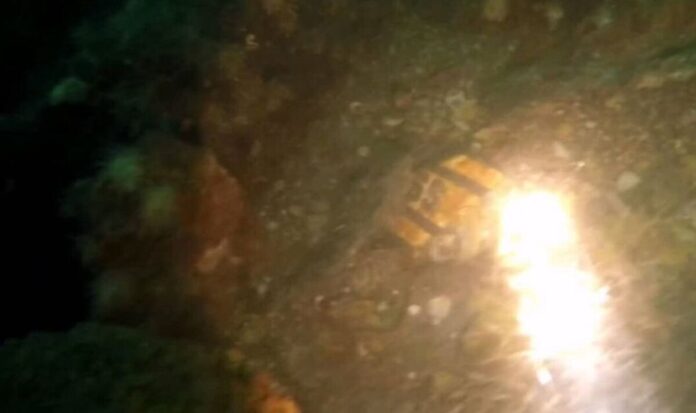A wreck found on the seafloor off the coast of Quequen, Argentina, may indeed be a U-boat after all, an expert has said – adding fuel to a controversial theory that the submarine was used in an elaborate deception to allow Adolf Hitler to escape Germany in 1945. The historical consensus is that Hitler died by suicide on April 30, 1945 in the Führerbunker in Berlin, after it became clear that Nazi Germany would lose the Battle of Berlin. Photographs of the 262-foot-long wreck were analysed by marine explorer Fabio Bisciotti, who leads the underwater study group at the Italian Naval League. He claims to have found several indicators that the vessel may have been a German U-boat – including a distinctive plate and various structural features including the remains of a conning tower.The shipwreck was discovered by the research group ‘Eslabon Perdido’ (Missing Link), whose leader Abel Basti has long been a proponent of the conspiracy theory that Hitler escaped the fall of Nazi Germany and made it to South America.According to Mr Basti, the U-boat was deliberately scuttled to cover Hitler’s tracks, before the fascist dictator was taken to a Nazi-owned ranch at Moromar, 24 miles north of Quequen, that was built by two German agents, Ludwig Freude and Thilo Martens.Local legend in the area has it that one Luis Mariotti – a policeman – was tasked with investigating reports of submarines landing along the coast around Quequen in 1945. Mr Mariotti is said to have followed truck tracks from the beach to the Moromar ranch, where men with machine guns prevented him from entering.Subsequently – the story goes – the policeman was instructed by his superiors to forget the whole matter. Meanwhile, declassified FBI documents are reported to contain one account from 1945 of Hitler reaching Argentina by U-boat – however, in that narrative, the vessel landed at the Valdes Peninsula, some 400 miles to the south of Quequen. A controversial theory suggests the wreck was used to smuggle Hitler to Argentina (Image: Getty Images / PEN NEWS) Among the photos of the wreck can be seen what may be hatches, a periscope, and a conning tower (Image: PEN NEWS)Analysing photographs of the wreck, Mr Bisciotti drew attention to a yellow plate, on which appears to be printed the letters ‘ss’ in a distinctive typeface. He said: Talking to other historians, we have discovered that this type of character is very similar to the German alphabet used during the war.’The plate’s colouration may also indicate that it was used on a submarine – with yellow providing the best contrast under the red lights used on submarines to preserve the crew’s night vision for using periscopes or going on watch.Mr Bisciotti explained: ‘In every submarine, it’s like this. Every plate or important item in a submarine is golden. Gold is the first and last natural colour able to be seen in darkness with red light.’For the explorer, the location of the wreck may also be suggestive of its origins. Mr Bisciotti said: ‘If we are talking about a submarine, yes, it could be German. Because this area was avoided by American or British warships, including submarines.READ MORE: Escaping after 75 years… the dark secrets of Colditz Castle The wreck was found on the seafloor off the coast of Quequen, Argentina (pictured) (Image: Creative Commons / Leandro Kibisz ) The historical consensus is that Hitler died by suicide on April 30, 1945 in the Führerbunker (Image: Bundesarchiv, Bild 183-V04744 / CC-BY-SA 3.0)’So, at the end of the war – May 1945 – if we are talking about submarines, it’s German.’ Furthermore, the size of the wreck seems to fit the bill, the expert said.He explained: ‘The dimension matched with a U-boat.’ Among the photos of the wreck can be seen what may be hatches, a periscope, and the possible remains of a conning tower.Mr Bisciotti said: ‘It’s quite destroyed and very, very ruined. But by the images I can see something very, very interesting – such as the deflector of the conning tower for the waves.’The U-boat has got a particular design, very similar to the SS uniform – it’s unique. We can’t confuse it with a British submarine – [they] are totally different.DON’T MISS:Iran claims to develop hypersonic missile that can ‘breach defences’ [ANALYSIS]Rishi handed £5bn ‘value for money’ energy lifeline to slash bills [REPORT]Octopus Energy shares boiler hack saving customers £112 a year [INSIGHT] Pictured: a painting of a German U-boat (Image: Creative Commons / Augusto Ferrer-Dalmau)’The design is quite similar to a German conning tower – so this is one of the proofs that maybe can bring us to the truth.’ Dr Bisciotti stressed that his opinion on the likely nature of the sunken vessel was his alone – and that he would have to dive down to the wreck if he was to identify it with confidence.He said: ‘Only if I go on the shipwreck can I be 100 percent sure.’ The explorer added that he takes no position on the theory that Hitler survived World War 2. Mr Basti, however, is adamant in his conviction. Speaking in September: ‘My main hypothesis – which I hate detailed in my books – is that Hitler fled to Argentina.’He added: ‘This could be the submarine that evacuated Hitler at the end of the war.’ Mr Basti’s notions regarding Hitler’s survival remain highly controversial – with members of his own research group even being reported to have distanced themselves from the claims.Earlier this year, when the wreck was found, experts urged the public to be sceptical of the alleged discovery.Historian Dr Steven Woodbridge of Kingston University, for example, said: ‘Until it can be fully verified by the Argentinian authorities, one has to tread very carefully.’The Argentine Naval Prefecture, which has dived the wreck, has declined to comment.
Wreck of ‘sub that helped Hitler escape’ may not be what it seems
Sourceexpress.co.uk
RELATED ARTICLES


